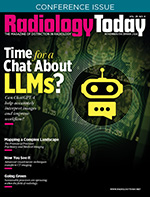 Nuc Med News: In With the Old?
Nuc Med News: In With the Old?
By Josh Hildebrand
Radiology Today
Vol. 25 No. 8 P. 32
Technegas exists as a feat of ingenuity within the lung imaging sphere. It was developed in Australia in 1984 for use in respiratory imaging due to its incredibly small particle size and ability to diffuse to the lung’s periphery when inhaled.1 Subsequent images were of an “unprecedented” quality, making Technegas immediately invaluable for the imaging of pulmonary embolism (PE) and other lung conditions.1 Since its inception, Technegas has been rolled out in 60 countries across the globe, with continued testing to widen its use.1 Notably, the United States was not among those 60 countries until late last year when the FDA approved the use of Technegas within the States, meeting clinical demands for its use.2
“Why it took so long to approve Technegas for public usage in the USA, I don’t know,” says Edward Sun, BSc, MRT(N), CTIC, a nuclear medicine technologist for University Health Network in Toronto. “[But] this is really not new technology.”
Ins and Outs
Being a radioaerosol, Technegas is created when technetium-99m, a radioactive isotope, is heated at high temperatures. This is done safely and efficiently using the aptly dubbed “Technegas generator,” a specialized machine manufactured and distributed by Cyclomedica, a nuclear medicine company leading the charge to cement Technegas as a mainstay for ventilation imaging.
Sun, who presented information about Technegas at this year’s annual SNMMI meeting, explains that, unlike traditional “plug-and-play” radioaerosol distribution methods, the generation process for Technegas is unique and requires several steps1:
• Technetium-99m pertechnetate solution is prepared in saline and heated using a graphite crucible.
• Argon is used as a purging gas to aid in the induction of evaporation to produce gas-like particles to be inhaled.
• Using a ventilation kit, the patient inhales the particles, allowing for imaging to take place.
Compared with the old “aerosol paint can” method, Technegas confers numerous benefits, Sun explains. For starters, the size of Technegas particles allows for far more precise imaging.
“Its gaslike particles are very small,” Sun says. “As a result, you get less clumping in the large airways, better distribution throughout the lungs, and it remains stable in that it does not wash out or get redistributed while administered to the patient.”
According to Sun, with no clumping and better distribution, physicians can more confidently make decisions related to the treatment of various respiratory conditions. These conditions include chronic thromboembolic pulmonary hypertension, asthma, and complications related to COVID-19, to name a few.3 However, Technegas is primarily used to aid in the diagnosis of PE. Once ventilation and perfusion images have been gathered, they are compared with SPECT or SPECT/CT to accurately diagnose PE.
“Technegas and SPECT have been a game changer in this regard because it has increased the sensitivity and specificity to help physicians diagnose PE,” Sun says. “Even in patients who have poor inspiration characteristics, ventilation with Technegas moves [into the necessary] areas of the lungs.”
Because Technegas doesn’t “wash out,” physicians cannot obtain dynamic functional data from the lungs, which is not the case with other radioaerosols, such as xenon-133. However, researchers are using this attribute to their advantage, obtaining instead diverse data from the lungs to predict the presence of various lung conditions prior to their presentation.
“Cyclomedica has sponsored several studies in Canada to help understand small airway disease in smokers,” Sun says. “They’ve also worked with surgical lung resection patients to predict the length of hospital stays based on their ventilation data.”
Technegas is also safer compared with the traditional “paint can” method. Ventilation kits on older delivery systems required oxygen to be funneled through to create the aerosol, necessitating an extra step to shut off the supply of particles. On occasion, Sun says, patients would remove their ventilation mouthpiece suddenly, running the risk of room contamination.
“With Technegas, this has not been an issue,” he says. “The operator controls the Technegas administration to the patient using handheld controls and the ventilation kits have one-way valves to prevent Technegas being blown into the ambient environment.”
Pushing Forward
According to Sun, the biggest hurdle to adopting Technegas is the initial cost. Various materials and equipment are needed for the use of Technegas, not to mention the generator itself, which requires its own specialized wall outlet for power. Additionally, routine maintenance is of the utmost importance to maintain a safe environment for both patients and physicians/staff. Departments understandably beg the question as to the need for a new device when standard, cheaper methods exist.
“CT pulmonary angiography will always be ‘king’ when clinicians query PE for their patients because it’s quick to do and every imaging department has a CT or two,” Sun says. “But [another] advantage of Technegas is that it reduces the radiation burden on the patient in comparison to CT pulmonary angiography and can be used in pregnant females and patients allergic to CT contrast.”
The move toward Technegas for ventilation imaging is an advantageous one and, given the FDA’s approval of its use within the United States, the conversation around Technegas and its uses should be expected to increase.
“It really comes down to the willingness of centers to use this technology,” Sun says. “Sometimes, you have to get over the initial inertia of what is familiar to [learn] what is possible. Hopefully [we will] tap into [different] audience[s] to get the discussion started amongst the frontline folks who have been using ‘paint cans’ for years.”
— Josh Hildebrand is the assistant editor of Radiology Today.
References
1. Khatib I, Young PM. Technegas, a universal technique for lung imaging in nuclear medicine: technology, physicochemical properties, and clinical applications. Pharmaceutics. 2023;15(4):1108.
2. United States FDA grants approval for Technegas. Cyclomedica website. https://www.cyclomedica.com/2023/10/02/united-states-fda-grants-approval-for-technegas/. Published October 2, 2023.
3. Technegas. Cyclomedica website. https://www.cyclomedica.com/products/technegas/

